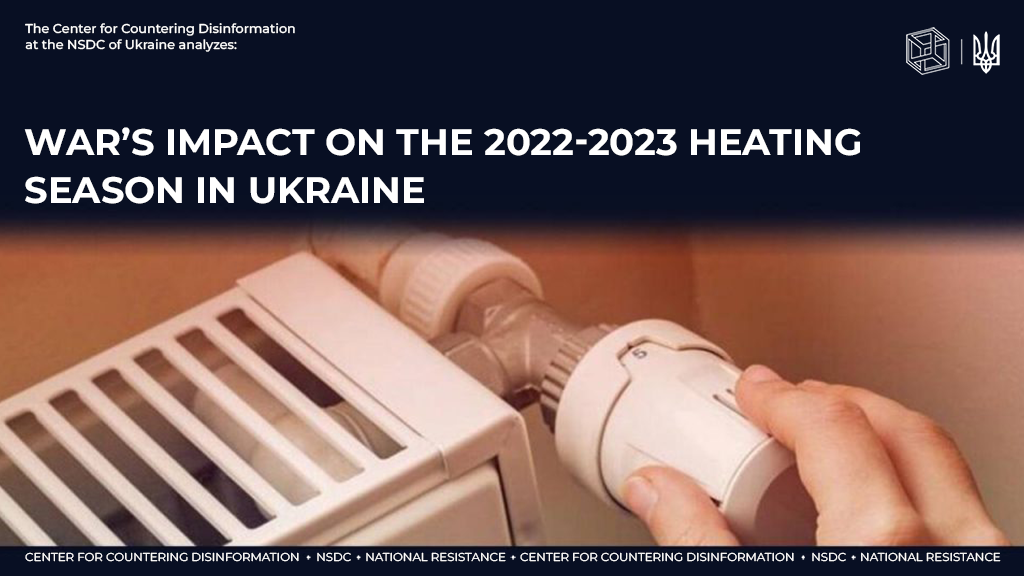The Center for Countering Disinformation at the NSDC of Ukraine analyzes the narratives of Russian propaganda regarding the preparation for the heating season in Ukraine and whether they correspond to the data, available in open sources, concerning the country’s readiness for winter.
In particular, the following statements are being spread to create discouragement:
● the shabbiness of the power system can leave the country without electricity in winter, and the GTS (Gas Transmission System) will shut down completely due to the lack of full maintenance;
● some regions are being prepared for evacuation due to lack of heating as a result of the malpractice of the authorities, while the Donetsk region is being “surrendered” and no money is being put into the budget in regard to heating.
At the same time, Russian propagandists carry on striking critical infrastructure facilities in order to deprive Ukraine of electricity, bridges, water, logistics, and all other amenities. According to them, this will certainly ensure the capitulation of Ukraine.
Most Ukrainian experts admit that the upcoming heating season will be one of the most difficult on account of the war, which has led to the destruction of critical infrastructure facilities. The key issue of this year’s heating season is possible attacks from the Russian side on our heat-generating facilities, and accordingly, the accessibility of coolants.
The most difficult situation with heat supply is in the cities, where critical infrastructure facilities have been significantly damaged as a result of shelling. Particularly, in Sumy, Chernihiv, Okhtyrka, and Kremenchuk, local combined heat and power plants that provide heating to the vast majority of urban housing have been damaged.
Therefore, the main risk factor of the heating season is not the amount of gas, but the destroyed objects of critical infrastructure that generate heat. In the front-line settlements, the infrastructure has already been destroyed to such an extent that it has become unfeasible to provide heat there. Hence, the authorities are calling on people to evacuate.
Despite the problems with the condition of critical infrastructure, the issue of gas storage capacity is of high importance as well. In order to accumulate fuel resources independently, the government has decided to ban the export of some types of fuel of Ukrainian origin, including fuel oil, coal, and natural gas.
A decline in gas consumption can be observed as a consequence of the decline in the volume of industry and the outflow of citizens in Ukraine. However, a decrease in gas production is also noticeable, as some of the fields have been taken over by the occupiers. Gas consumption in Ukraine has decreased by 40% since the beginning of the war, meaning that there should be enough domestically produced natural gas to get through the 2022/2023 heating season.
There are 13 natural gas storage facilities and 4 gas recovery systems in Ukraine: western, eastern, southern, and central. The main gas deposits are located in Prykarpattya, Dnipro-Donetsk, and Black Sea-Crimea oil and gas regions.
According to the government, there are already 11.3 billion cubic meters of gas in Ukrainian storage facilities. By the beginning of the heating season, “Naftogaz” has to stock 19 billion cubic meters of natural gas. It implies that there has already been accumulated more than half of the gas amount required for the heating season. Besides, “Naftogaz” continues the import of gas, and about 1 billion cubic meters of domestically produced gas is added to the reserves every month.
In general, according to the government, Ukraine is 60% ready for the heating season, residential buildings – 56%, networks – 57%, heat supply facilities – 58%. Damaged infrastructure is also being restored. As a consequence of the war, 327 heat supply facilities have been damaged: 316 boiler houses, 10 CHP (combined heat and power) plants, and 1 TPS (thermal power station). 156 boiler houses located in relatively safe areas have already been restored.
To solve the problem with the gas supply, the central and municipal authorities are working to implement alternative heating sources without increasing tariffs. Additional solid fuel boilers, designed for the fuel available in the specific region: coal, peat, firewood, straw, and pellets, are already being installed in many gas boiler houses.
According to the Ministry of Energy, the capacities of Ukrainian nuclear energy are sufficient to provide the population with electricity. Funds have been allocated from the reserve fund for the purchase of urgently required mobile equipment. Gas and solid fuel mobile boilers, a diesel generator, other necessary equipment, as well as diesel fuel are to be purchased.
A legislative moratorium has been imposed on the increase of tariffs on gas, heating, and hot water. Tariffs for domestic consumers in Ukraine will be fixed. In a time of war, prices for gas and heat must be kept at the level of UAH 7420 per thousand cubic meters of gas. At the same time, industrial enterprises will buy gas at the market price.
The destruction of heat supply systems and residential buildings is a considerable problem in the front-line territories. Due to the damaged supply systems and the inability to repair the buildings, it is impossible to provide citizens with heat. The solution is in the temporary evacuation of the population to safe regions or the creation of special heating centers with mobile boilers.
The transition of high-rise buildings to potbelly stoves or electric heating is too risky. Outdated electrical wiring is not likely to withstand the load, which may cause fires.
The Center for Countering Disinformation at the NSDC of Ukraine has already reported https://cpd.gov.ua/main/czpd_analizuye-23/ that beginning from February 24, 6% of the area of the housing stock has been lost. More than 3.5 million people, which is 8% of the country’s population, were left homeless. Some of them moved to other regions, while others stayed in damaged houses. As soon as the temperature starts to drop, such buildings will become uninhabitable.
Thus, meticulous preparation for the heating season is part of the viable defense of the state. Like any other year, hostile propaganda tries to sow panic among the population as a means to undermine confidence in the Ukrainian authorities.
Considering the need to save energy, Ukrainians should get prepared for a decrease in the temperature regime in apartments with central heating and a possible lack of hot water. Furthermore, it is advisable to save electricity to maintain the stability of the entire system.
Taking into account possible Russian attacks that aim to destroy critical infrastructure, it is essential to be psychologically and financially prepared for a possible sudden shutdown of heating. At the same time, responsible state bodies should accumulate repair equipment and materials for possible emergencies.










